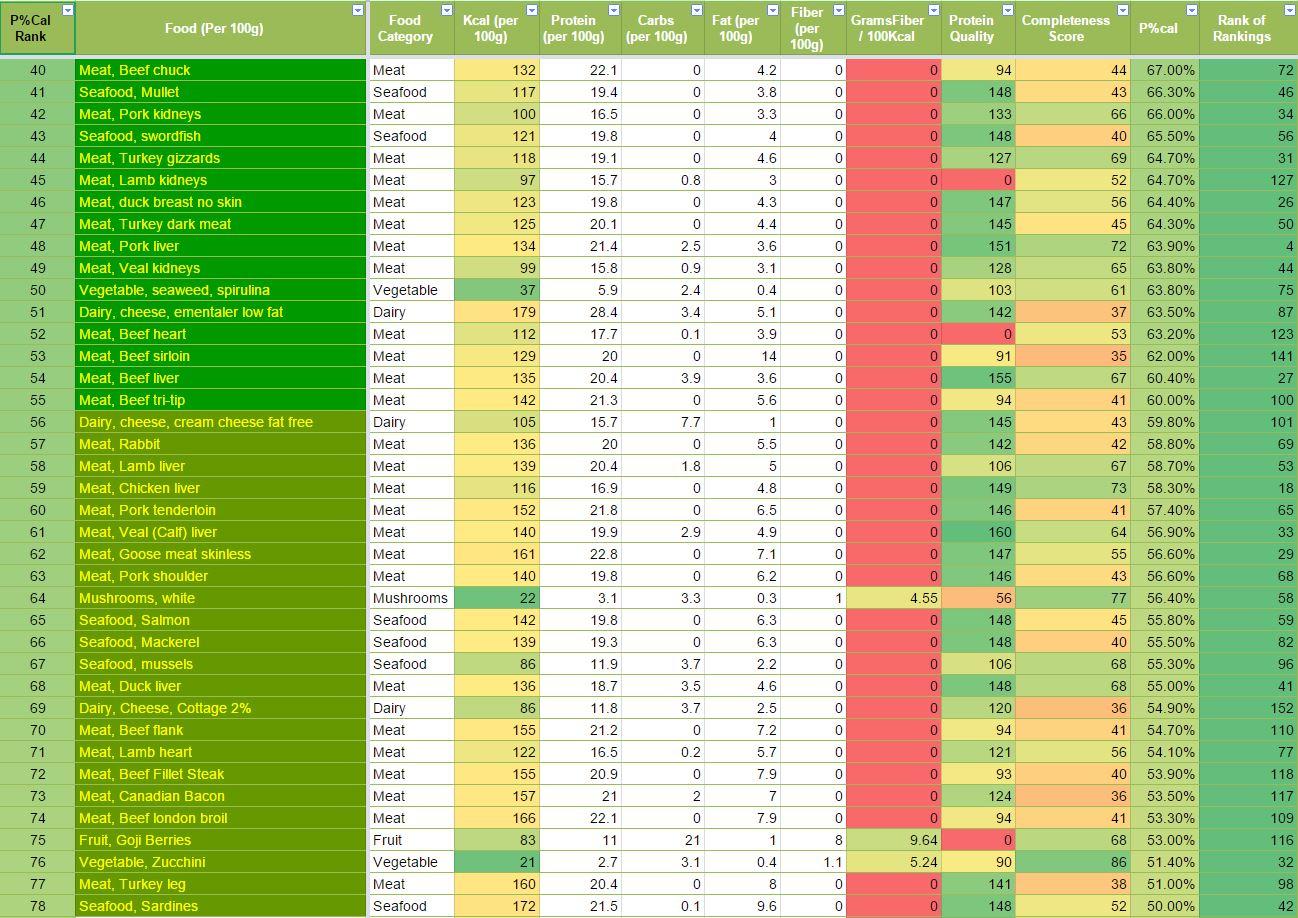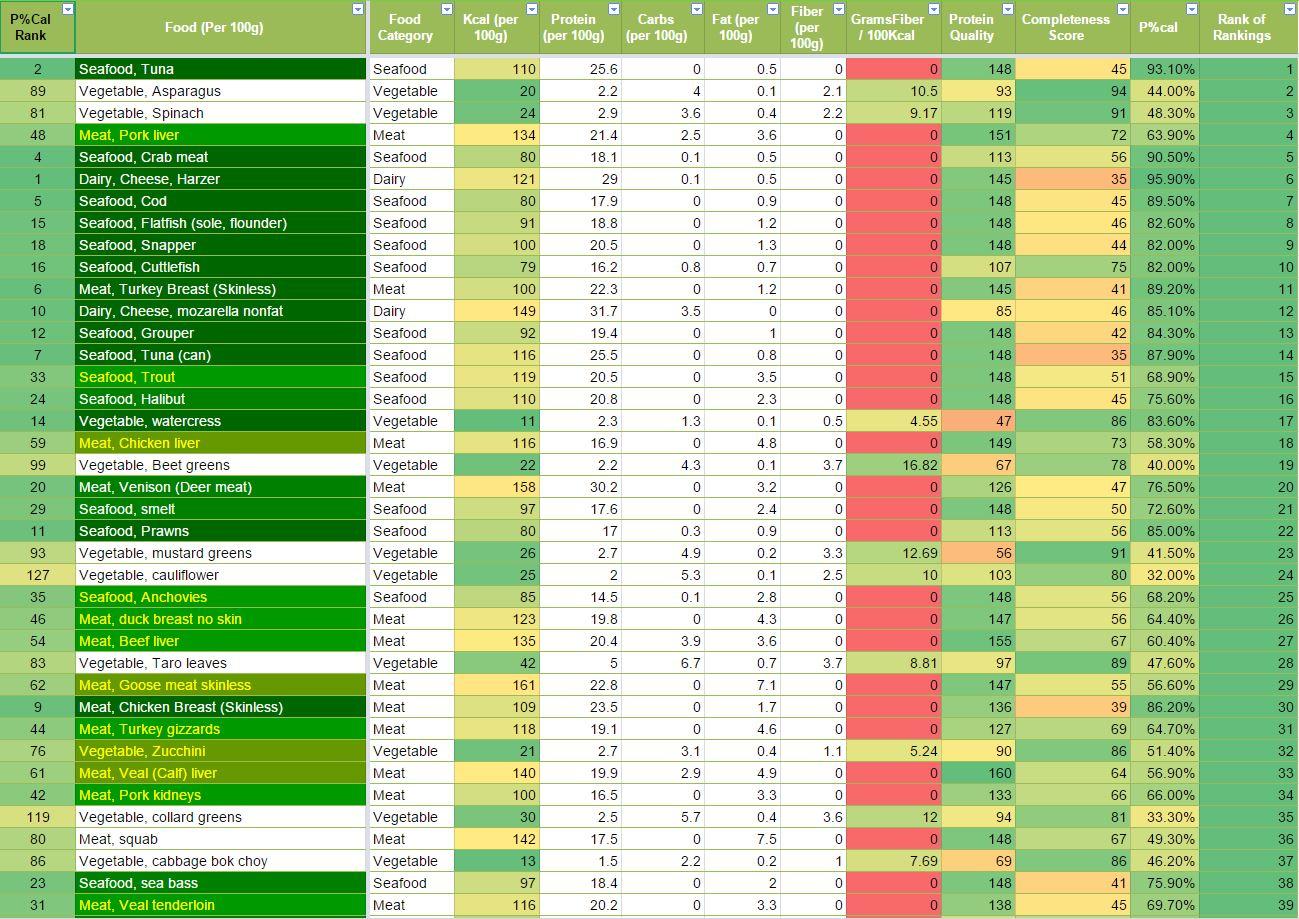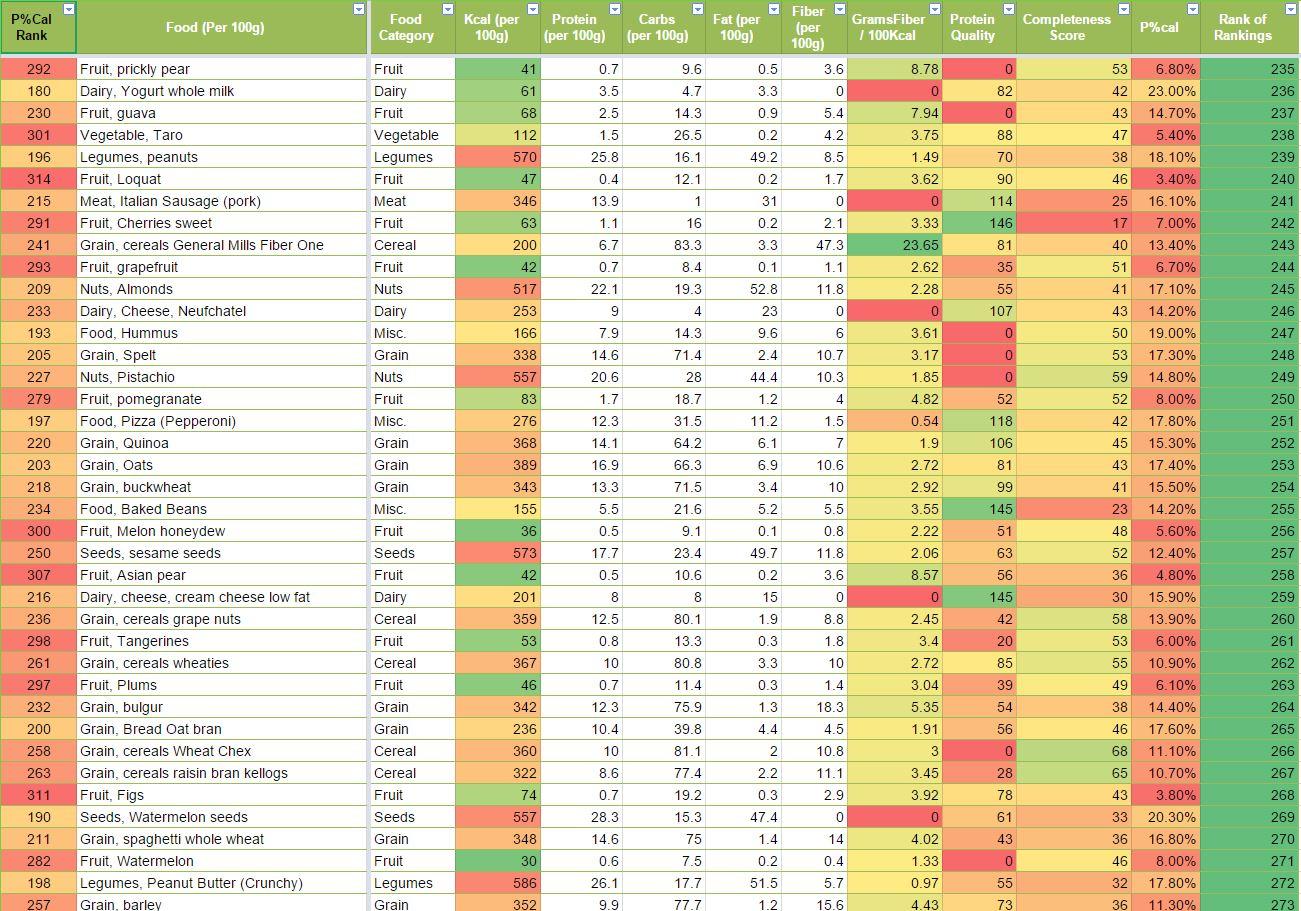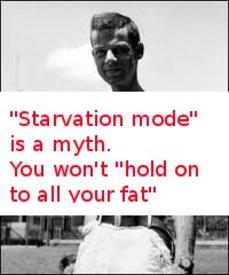Carbs and Fats are cheap. Here's a Guide to getting your PROTEIN's worth. Fiber also...

andrikosDE
Posts: 383 Member
Below you can see the link to the Google Spreadsheet that I created containing 318 foods (as of 5th Sept. 2015) which shows the following:
Column - Title - Meaning
There you have it.
Have fun browsing the list.
https://docs.google.com/spreadsheets/d/12LrMGp8HiWl2FW-odoexKBMxeDTMUhwd4ooT6VoolJk/edit#gid=0
PS If anyone wants to add more info, please let me know and I can provide you with editing privileges.
Column - Title - Meaning
- A - P%Cal Rank - Ranking of food by Protein Kcal / Total Cals (Highest is ranked 1st)
- B - Food - Food Name
- C - Food Category - 1 of 12 food categories
- D - Kcal - Caloric content of 100g of food (EU standard)
- E - Protein - Protein content per 100g of food (also doubles as a percentage)
- F - Carb - Carb content per 100g of food (also doubles as a percentage)
- G - Fat - Fat content per 100g of food (also doubles as a percentage)
- H - Fiber - Fiber content per 100g of food (also doubles as a percentage)
- I - Grams Fiber/100kcal - This is the fiber bang for your caloric buck information. Especially good for calorie-restricted diets
- J - Protein Quality - This info is taken from the nutritiondata.self.com site. More info here: https://nutritiondata.self.com/help/analysis-help#protein-quality

- K - Nutrient Completeness info - This info is taken from the nutritiondata.self.com site. More info here: https://nutritiondata.self.com/help/analysis-help#nutrient-balance-indicator

- L - P%Cal - Percentage of how many calories of protein as compared to the total calories of the food. In essence, this is the reason this spreadsheet exists.
- M-U - Hidden columns - They contain all the ranking of columns B-K above and are used to calculate the overall ranking of the food list.
- V - Rank of Rankings - Takes all the rankings above (M-U) and averages the rankings. The highest average ranking (lowest number) is the top food based on the above criteria (Seafood, tuna) and the bottom has the lowest (Food, Chocolate Dark 45-59% cacao). It doesn't mean that the bottom-ranked food is "bad", it just means that it's not the best bank for the buck in regards to the above criteria.
There you have it.
Have fun browsing the list.
https://docs.google.com/spreadsheets/d/12LrMGp8HiWl2FW-odoexKBMxeDTMUhwd4ooT6VoolJk/edit#gid=0
PS If anyone wants to add more info, please let me know and I can provide you with editing privileges.
103
Replies
-
-
-
Here's the ranking of all FIBER containing foods.
They are ranked by GRAMS of FIBER per 100kcal.
This gives us a "fiber bang for your caloric buck" overview.
You'll be surprised at how poorly some "fiber rich" cereals and grains do on this list...
But that's what science vs. marketing does: surprises us. Numbers speak the truth.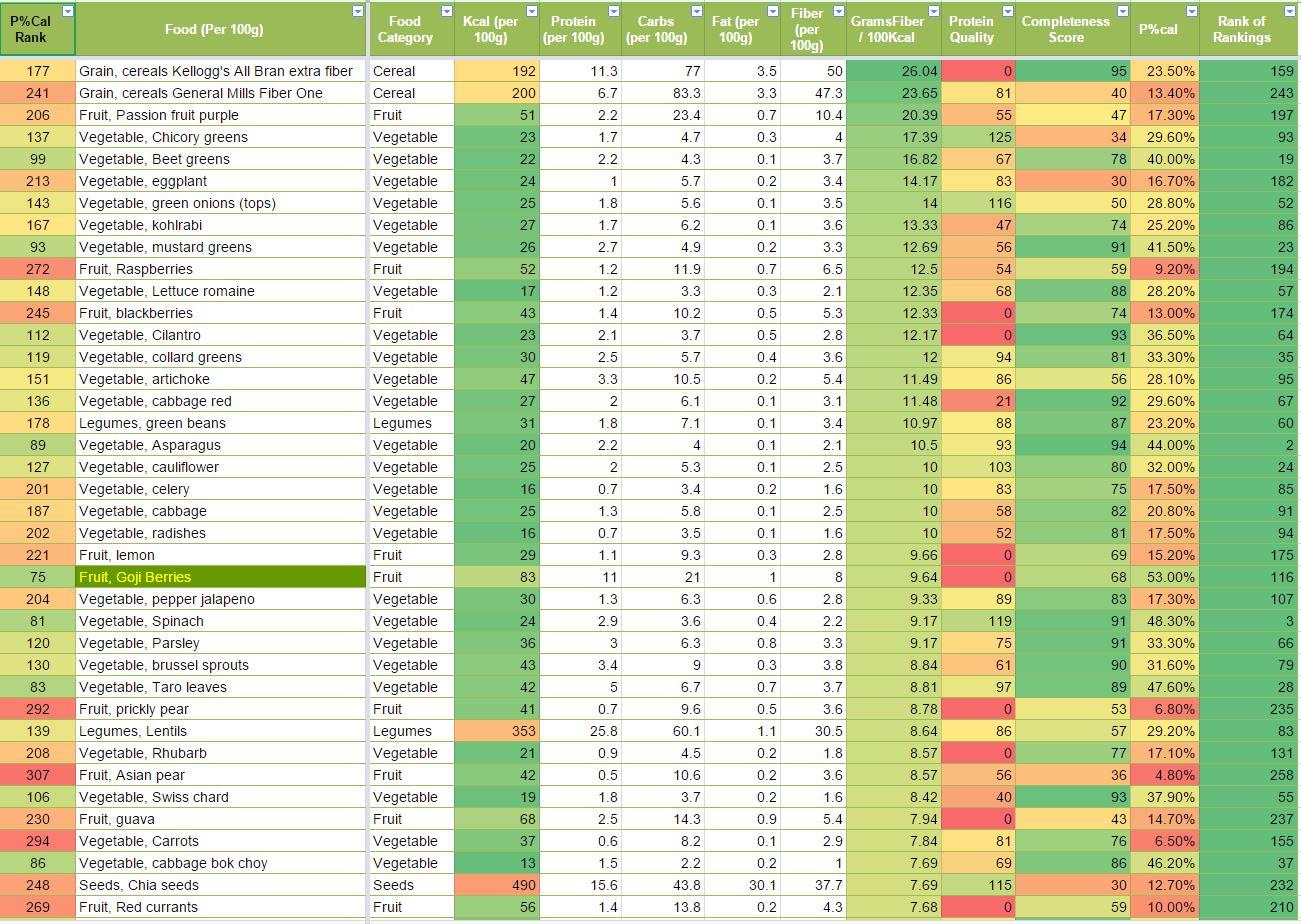

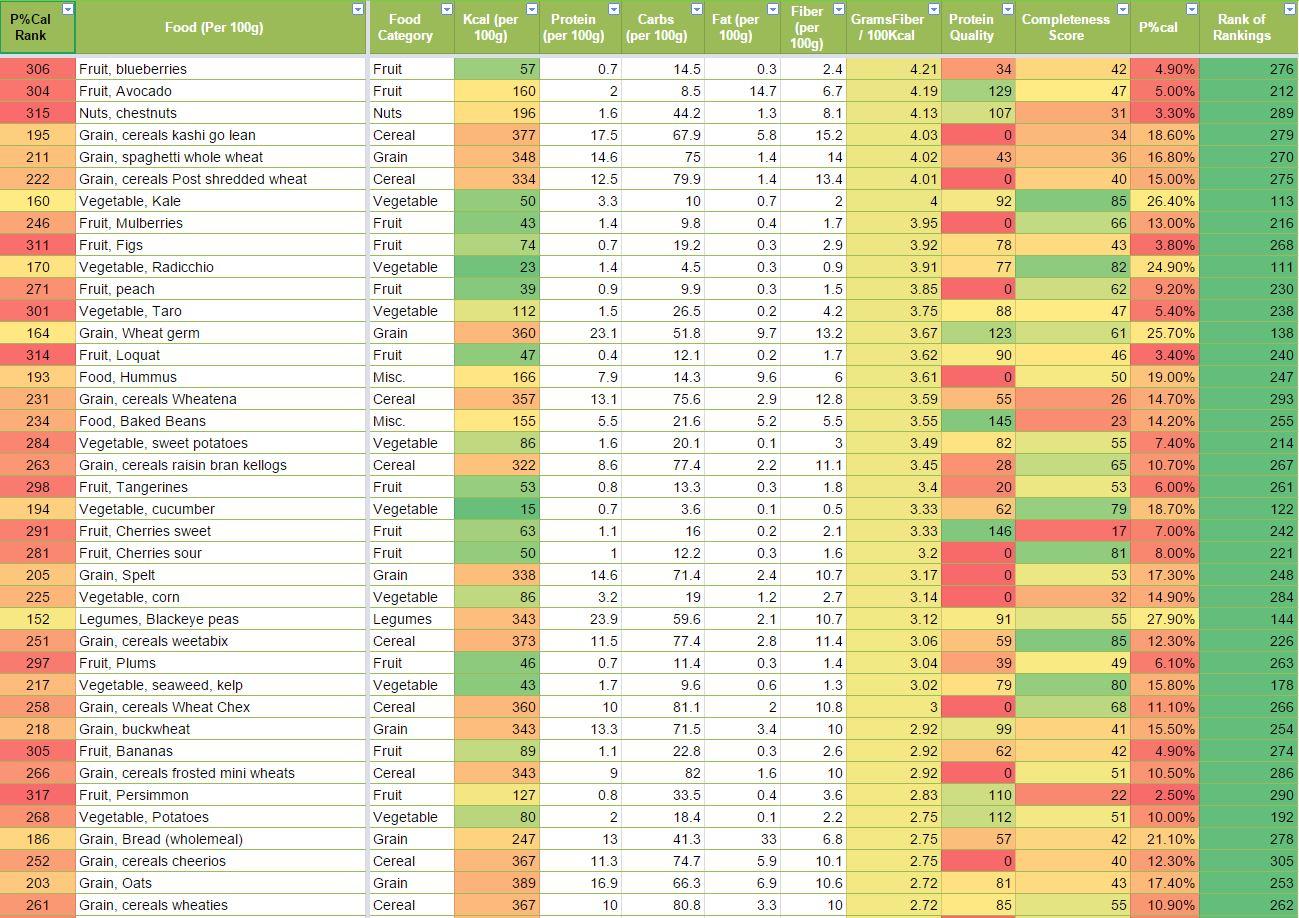


10 -
Interesting. I thought you were going to throw cost ($) in there too from the title.4
-
Interesting. I thought you were going to throw cost ($) in there too from the title.
Actually I am working on that.
However, since I live in Germany, I'm not sure how relevant the prices will be to you.
If anyone is interested to add the US (or other countries') prices, let me know and I'll give you editing permissions.10 -
Just to thank you and to follow the thread1
-
Interesting. I have a couple of questions:
How was nutritional value and ranking determined?
Was fibre included in the nutritional ranking? (I'm not much of a believer in the benefits of fibre for myself.)1 -
Wow thanks, that's freaking awesome, congrats on the dedication and hard work I assume you put into this
Loving that tuna is number 2/4 ! 9
! 9 -
@andrikosDE thanks for that hard work. My protein macro is 15% and fat is 80% so this helps at a glance to find new foods I can add.6
-
following. Thanks for the information!0
-
you should do a vegetarian option6
-
Nice work!2
-
Interesting. I have a couple of questions:
How was nutritional value and ranking determined?
Was fibre included in the nutritional ranking? (I'm not much of a believer in the benefits of fibre for myself.)
If I understand your question well, you're asking how I calculated the "rank of rankings" list?
"rank of rankings" is the average ranking of all columns (D through L). As you can see, Protein is counted 3 times: Protein content, P%cal and protein quality (numbers of and quantities of all essential aminoacids).
Fiber, naturally only occurs in plant based foods so all meats, seafood and dairy get a rank of 174 and, yes, it's one of the criteria.
Also, carb content is ranked by the carb-fiber calculation as fiber content is not counted as calories.4 -
andrikosDE wrote: »Interesting. I have a couple of questions:
How was nutritional value and ranking determined?
Was fibre included in the nutritional ranking? (I'm not much of a believer in the benefits of fibre for myself.)
If I understand your question well, you're asking how I calculated the "rank of rankings" list?
"rank of rankings" is the average ranking of all columns (D through L). As you can see, Protein is counted 3 times: Protein content, protein quality, P%cal and protein quality (numbers of and quantities of all essential aminoacids).
Fiber, naturally only occurs in plant based foods so all meats, seafood and dairy get a rank of 174 and, yes, it's one of the criteria.
Great. Thanks. 0
0 -
-
vadimknobel wrote: »you should do a vegetarian option
All you have to do is filter out all the content that you don't want to see. There are many versions of vegetarians and all can be served by filtering out whatever food category they don't want to see.
The spreadsheet link is in the first post.
If you don't know how to do it, let me know.
Also, feel free to post your results. 13
13 -
Awesome work, thank you!0
-
Tagging for reference. Thanks for doing the work.2
-
This content has been removed.
-
Thank you for all your work. I'm glad this thread came back in a new and happy (so far) form. The information you've put together is so useful!6
-
Wow, thank you! Bookmarked.1
-
Sweet! Thanks a lot for the work you put into this.0
-
That is great, thank you!0
-
It's interesting to notice how many items at the top of the ranking are budget friendly, so it is definitely possible to eat a nutritious diet also on a budget.
Ah can you add a "z" to mozzarella?
(thanks again for sharing this)2 -
Gianfranco_R wrote: »It's interesting to notice how many items at the top of the ranking are budget friendly, so it is definitely possible to eat a nutritious diet also on a budget.
Ah can you add a "z" to mozzarella?
(thanks again for sharing this)
Haha! I added the extra z, thanks for pointing it out.
The cost column is up and there are new rankings !2 -
With all this hard work, you want to see if you can make it into an APP (not sure how all that works). I bet you'd have a few takers for it.4
-
Wow! Thank you for your work! That's a few numbers to crunch
 2
2 -
tennisdude2004 wrote: »With all this hard work, you want to see if you can make it into an APP (not sure how all that works). I bet you'd have a few takers for it.
You are very perceptive. It's in the works. 4
4 -
I'm having trouble blowing up the chart to where I can actually read it . I'm on Android app, is anyone else having trouble seeing it ?4
Categories
- All Categories
- 1.4M Health, Wellness and Goals
- 398.1K Introduce Yourself
- 44.7K Getting Started
- 261K Health and Weight Loss
- 176.4K Food and Nutrition
- 47.7K Recipes
- 233K Fitness and Exercise
- 462 Sleep, Mindfulness and Overall Wellness
- 6.5K Goal: Maintaining Weight
- 8.7K Goal: Gaining Weight and Body Building
- 153.5K Motivation and Support
- 8.4K Challenges
- 1.4K Debate Club
- 96.5K Chit-Chat
- 2.6K Fun and Games
- 4.8K MyFitnessPal Information
- 12 News and Announcements
- 21 MyFitnessPal Academy
- 1.5K Feature Suggestions and Ideas
- 3.2K MyFitnessPal Tech Support Questions

